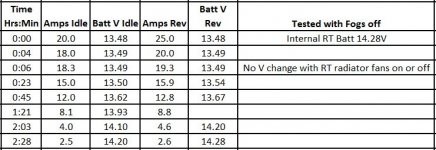WA5VHU
New member
We had an Aliner camping trailer we pulled with our car but we replaced it with a Combi-Camp motorcycle camping trailer so we could pull it behind our Spyder. (The Aliner is still for sale if anyone is interested). Where we camp at the beach there are no hookups for the trailer so we kept the Aliner battery charged with either a Honda EU2000i generator or a 1,000 Watt inverter in the car. With the Spyder and the Combi-Camp we can’t really haul a heavy generator to recharge the camper battery so I thought I would check out the 2014 Spyder’s new alternator charging capacity.
What I found was very impressive.
I am using a brand new Harbor Freight 12V 35AH AGM battery. Using my AC house powered battery charger/discharger I first charged the battery then discharged it to about 50% (11.92V), about 18AH out of the battery, to make sure it met specifications (it did). I then took the battery out to the driveway and charged it back up with the Spyder.
The #10 gauge wiring connecting the two batteries had about 0.1Ω resistance, which helped limit the inrush current when the discharged camper’s battery was initially connected across the Spyder’s battery.
It only took about 2½ hours to recharge the battery. The Spyder didn't seem to mind idling for that long and the alternator didn't seem to mind the load either. It was 55° and sunny outside, the Spyder’s temperature gauge stayed in the middle and the fans cycled occasionally. Revving up the engine resulted in only a small increase in charge current, not worth worrying about it.
I will use a battery isolator http://www.batterymart.com/p-acc-20090-battery-isolator.html and put the camper’s battery in the back trunk of the Spyder, with heavy gauge wire run up to the Spyder’s battery. With this setup we can charge the camper’s battery as we ryde around during the day or even just idle the Spyder at the campground if necessary.
The chart below shows some of the details of the test:

What I found was very impressive.
I am using a brand new Harbor Freight 12V 35AH AGM battery. Using my AC house powered battery charger/discharger I first charged the battery then discharged it to about 50% (11.92V), about 18AH out of the battery, to make sure it met specifications (it did). I then took the battery out to the driveway and charged it back up with the Spyder.
The #10 gauge wiring connecting the two batteries had about 0.1Ω resistance, which helped limit the inrush current when the discharged camper’s battery was initially connected across the Spyder’s battery.
It only took about 2½ hours to recharge the battery. The Spyder didn't seem to mind idling for that long and the alternator didn't seem to mind the load either. It was 55° and sunny outside, the Spyder’s temperature gauge stayed in the middle and the fans cycled occasionally. Revving up the engine resulted in only a small increase in charge current, not worth worrying about it.
I will use a battery isolator http://www.batterymart.com/p-acc-20090-battery-isolator.html and put the camper’s battery in the back trunk of the Spyder, with heavy gauge wire run up to the Spyder’s battery. With this setup we can charge the camper’s battery as we ryde around during the day or even just idle the Spyder at the campground if necessary.
The chart below shows some of the details of the test:


